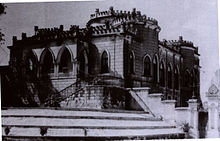Asman Jah
His Excellency Nawab Mohammad Mazahr ud-Din Khan Asman Jah Rafath Jung, Bashir ud-Dawla, Umdat ul-Mulk, Azam ul-Umara, Amir-i-Akbar, Bahadur, KCIE (* 1839 in Hyderabad ; † 1898 in Hyderabad ), was nobleman of the Indian princely state of Hyderabad . At the time of Asaf Jah VI. Member of the Privy Council and divan from 1887–1893 .
Life path
Asman Jah was the eldest son of Sabkat Jung (= Bashir-ul-Mulk) from the older line of the sons of Shams ul-Umara (Diwan 1848/9; = Amir-i-Kabir I. ). As such, he was a great-grandson of Asaf Jah II. The clan was, after the ruler, the country's second largest landowner (as paigah committed to military success). Traditionally, the family provided the commanding officer of the principality's troops. His brother Khurshid Jah and cousin Viqar ul-Umara also held top state offices in the 1890s. He was, as his relative Viqar-ul-Umra, a daughter of Asaf Jah V. married.
After the death of his uncle, while Asaf Jah VI was a minor . he became co-regent next to Salar Jung I. While the latter traveled to England, he led the affairs of state. Asam Jah represented his uncle at the reception of the Prince of Wales in Bombay, at the following imperial durbar in Delhi he was in the wake of eleven-year-old Asaf Jah VI, who made his first public appearance there on Proclamation Day . He was awarded the Delhi Medal .
As a representative of the Nizam, he traveled to London in 1887 to celebrate the golden jubilee of Queen Victoria's throne , where on the fringes, through Abdul Huq, the award of the nationwide mining concession to the Hyderabad (Deccan) Company was arranged. A week after his return he was, succeeding Salar Jung II. , The Council appointed an office which had been perceived earlier as business director. At the end of his term of office, the decree Qanoon-cha-Mubarak (February 20, 1893), which provided a minimal say , and Imud ul-Mulk and the private secretary of the Nizam Server Jung were instrumental in drafting it . He was succeeded in office by Viqar ul-Umara.
He had a splendid garden laid out in the Bashir Bagh family residence , as well as the Asman Ghar Palace in the English-neo-Gothic style in the suburb of Mallapet. To the north of the Falkanuma Palace , the magnificent Jahanuma Palace was built in his name .
Literature and Sources
- Lethbridge, Roper; Golden Book of India; 1893, pp. 30-2
| personal data | |
|---|---|
| SURNAME | Asman Jah |
| ALTERNATIVE NAMES | Mohammad Mazahr ud-Din |
| BRIEF DESCRIPTION | Nobleman and co-regent, member of the Privy Council and Dīwān (1887-1893) |
| DATE OF BIRTH | 1839 |
| PLACE OF BIRTH | Hyderabad |
| DATE OF DEATH | 1898 |
| Place of death | Hyderabad |


